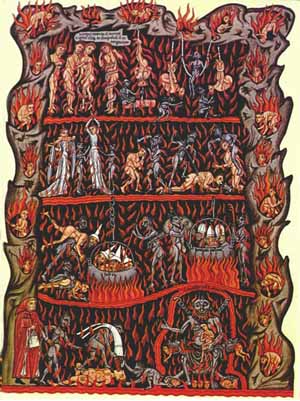 |
Stories & Legends
Thus Were the Bishops of Better Times...
Hugh O’Reilly
St. Dunstan (c. 909 – 988) was Abbot of Glastonbury, Bishop of Worcester, Bishop of London, and Archbishop of Canterbury. His work restored monastic life and had a decisive role in bringing back discipline and fervor in the entire Catholic Church in England. St. Dunstan served as an important minister of State to several Kings. He was the most popular saint in England for nearly two centuries, having gained fame for the many stories of his greatness.
Once while King Edgar of England was passing by a convent in Wilton, he listened to a temptation of the Devil and violated the virginity of a young lady of a noble family who was preparing to take the religious veil. It was a great scandal that increased in gravity because the King was married.

St. Dunstan seated at the side of King Edgar |
When St. Dunstan learned of the fact, he went at once to look for the King. The latter, as customary, greeted the Archbishop and took his hand to invite him to come up to his royal throne.
Violently removing his hand from that of the King, the Saint looked at him with a terrible gaze and said: “How dare your impure hand touch the hand of a priest? Did it not just recently rob from God a virgin who was destined for Him? You corrupted a Spouse of the Creator and courteously pretend to pacify a friend of the outraged Husband? I do not want to be a friend of an enemy of Jesus Christ.”
The King, who until then did not know that St. Dustan was aware of what he had done, received the censure as a strike of lightning from Heaven. He repented, knelt at the feet of the Saint, and, weeping, confessed his crime and implored pardon.
St. Dustan made the King stand up. His face calmer now, he spoke sternly to the King about the salvation of his soul, painting with vivid colors the gravity of his sin. When he saw that King Edgar had sincerely repented, he imposed this penance: For seven years the King could not wear his crown. He should fast two days every week during that time, and give large alms. The Saint further prescribed that the King should found another convent of nuns, so that many virgins could be consecrated to the Lord to replace the one he had stolen. Also, he ordered that he should expel the bad priests from the Church and only make just laws pleasing to God.
King Edgar carried out everything that had been ordered. At the end of the seventh year, St. Dustan gathered all the Nobles, Bishops and Abbots of the Kingdom, and in the presence of all the people, replaced the crown on the head of the penitent King.

Stressing the danger of going to Hell, St. Dunstan converted King Edgar and the adulterous Count |
A powerful Count illegitimately entered into a marriage with one of his relatives. St. Dustan had warned him thrice not to do so, but he did not pay heed to his words. Therefore, the Saint forbade the Count to enter any church in his Archdiocese.
The offending Count went to implore protection of King Edgar, who interceded for the Count. Surprised at how easily the King had been won over by the Count, St. Dustan refused to take his request for leniency into consideration. Instead, he again censured the Count, who became increasingly obstinate. Then, the Saint excommunicated him.
Upset, the Count went to Rome, where he used his standing and power to influence Roman nobles to intercede for him with the Pope. He managed to obtain a letter signed by the Pope commanding Archbishop Dustan to reconcile the Count with the Church. St. Dustan answered: “I will obey My Lord the Pope willingly as soon as you repent of your sin.”
Conquered by the inflexibility of the Saint, ashamed of the excommunication and fearful of Hell, the Count finally renounced his illicit marriage.
At a Council of the entire Kingdom convened by St. Dunstan, the Count – barefoot and wearing a rough woolen tunic – appeared before the Archbishop and fell to his knees, repenting of his sin. At first, St. Dustan first maintained his severe countenance, but after listening to the requests of the assembly, he absolved the penitent Count.

Based upon and translated from
Rohrbacher, Vida dos Santos, vol. 9, pp. 51-52
Posted October 24, 2009


Related Topics of Interest
 St. Louis IX, King of France St. Louis IX, King of France
 The Eucharistic Miracle of Avignon The Eucharistic Miracle of Avignon
 The Tumbler of Our Lady The Tumbler of Our Lady
 Ranulf of Chester Ranulf of Chester
 The Man Who Sold His Soul to the Devil The Man Who Sold His Soul to the Devil
 The Miracle of Ourique and the Birth of Portugal The Miracle of Ourique and the Birth of Portugal
 Translation of the Holy House to Loreto Translation of the Holy House to Loreto

Related Works of Interest
| |
|
Legends | Religious |
Home | Books | CDs | Search | Contact Us | Donate

© 2002-
Tradition in Action, Inc. All Rights Reserved
|
 |
|